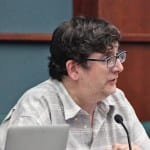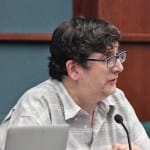Bloomington’s city council OKs bonds for county TIF district roads, different sewer rates for city, non-city customers



The line separating the part of Monroe County that’s inside Bloomington from the part that’s outside the city formed a common thread across three agenda items on the city council’s Wednesday agenda.
The council approved a sewer rate increase for all of Bloomington’s customers. For the first time, the rate is different for customers inside the city limits compared to outside. Customers inside the city limits will see a 3-percent increase, or about 72 cents more per month for an average customer. For an average customer outside the city, the 15-percent increase works out to $3.60 more per month. The differential rate increase passed on an 8–1 vote, with Chris Sturbaum dissenting, based on the differential character of the rates.
City limits also played a role in a revision to the city’s ordinance on sewer connection fees, which was also approved by the council Wednesday night. The point of the revision was to allow the director of utilities to waive connection fees in a couple of basic situations—for a single-family affordable housing project inside the city limits, or for the purpose of disconnecting a property from a septic tank. In the week between the city council’s committee-of-the-whole meeting a week ago, and Wednesday night, the wording was amended to make clear: The septic tank scenario for a waiver is not confined to customers inside the city limits. The council’s vote on the possibility of sewer connection waivers was unanimous, in favor.
Finally, the council approved issuance of $8 million of bonds by the Monroe County’s redevelopment commission, for construction of two new roads outside of town near the western edge. One road will extend Profile Parkway to Gates Drive. The other will extend Sunrise Greeting Court from Vernal Pike down to Gates Drive. The issue was in front of the city council because the county’s TIF district that’s providing the funding includes some land that the city annexed, after the TIF district was established. The council’s vote was unanimous, in favor.
Differential sewer rates
For the first time City of Bloomington Utilities (CBU) will be treating customers inside and outside the city as separate classes of customers. It’s a possibility recognized in state law, and based on a higher cost of the sewage collection for customers outside the city limits. The cost of treating sewage is the same, no matter where it comes from. But per customer it’s more cost efficient to collect sewage from areas with higher population density.
Utilities director Vic Kelson said at Wednesday’s meeting there are about 22,500 customers overall, and about 4,000 of them outside the city.
As members of the Bloomington Utilities Service Board drew out, during their Sept. 3 meeting, a differential cost of service exists even inside the city limits. And if customers currently outside the city were annexed into the city, their cost of service would not change, but the inside-city rates would be adjusted, so that recently annexed customers would match those of other customers inside the city. It’s a point that councilmembers also made during their committee-of-the-whole meeting a week ago.
The causes for this rate increase, which comes after a 22-percent increase three years ago, will pay for inflation, plus about $30 million to fund expansion projects for the city’s treatment plants. The city has received early warning letters from the Indiana Department of Environmental Management about the Dillman Road plant—it went over 90-percent of its rated capacity for a few years in a row.
On the city council, some back and forth unfolded between Steve Volan and Chris Sturbaum over the differential cost between city and non-city customers.
Volan said the difference in rates is based on the difference in the cost of delivering the service, and that state law allows rate classes to be defined by whether a customer lives inside or outside the city. The proposal from CBU had been level-headed and he considered it to be righting a wrong—there should have been differential rate classes for a while now, Volan said.
If there are people outside the city who have a problem with that, they should get in touch with their state representatives, Volan said, especially given that the state legislature is willing to regulate what cities can and cannot do. He pointed to Bloomington’s inability to enact tiered water rates based on usage as an example of that. Volan said that the rate increase proposal had been a “good education in the mechanics of city government.”
Council president Dave Rollo said “it just stands to reason” that people who live compactly inside the city should not subsidize those who live less densely outside the city.
Chris Sturbaum said he appreciated the rational justification for the higher rates for non-city customers. But he said he thinks the lines between city and county are arbitrary. He said Bloomington utilities should be serving the region, and the rate should be flat.
Voan responded to Sturbaum’s characterization of the city boundary as “arbitrary,” saying that it’s a line that determines a land owner’s property tax rate. If that line didn’t matter, Volan said, there wouldn’t have been such an uproar about the city’s effort to annex territory two years ago.
The connection of the differential sewer rate increase to the 2017 annexation effort—which ended with a law passed by the legislature suspending Bloomington’s effort, and is still being litigated—came up during public commentary at last week’s council committee-of-the-whole meeting. A speaker said he was grabbling with the “coincidence” of the differential rates. Some of the commentary The Beacon has heard from quarters outside the city has called the differential rates “punitive” in response to the foundered annexation effort.
Sturbaum responded to Volan saying the boundary was “cosmically arbitrary”—he wanted to leave it at that.
The 12-percent outside-the-city surcharge is reflected in both the usage charge and the monthly service charge.
Usage Charge (per 1,000 gallons)
| Current | Approved | |
| Inside City Customers | $7.76 | $7.99 |
| Outside City Customers | $7.76 | $8.95 |
Monthly Service Charge
| Current | Approved | |
| Inside City Customers | $7.95 | $8.19 |
| Outside City Customers | $7.95 | $9.17 |
The following charts show some typical customer bills based on the monthly service charge and the usage rates.
An average inside-the-city customer uses 3,300 gallons of sewage service a month. Outside the city, an average customer uses 3,700 gallons of service.
Inside the City
| Gallons | Current | Approved | Difference |
| – | $7.95 | $8.19 | $0.24 |
| 3,000 | $31.23 | $32.16 | $0.93 |
| 5,000 | $46.75 | $48.14 | $1.39 |
| 7,000 | $62.27 | $64.12 | $1.85 |
Outside the City
| Gallons | Current | Approved | Difference |
| – | $7.95 | $9.17 | $1.22 |
| 3,000 | $31.23 | $36.02 | $4.79 |
| 5,000 | $46.75 | $53.92 | $7.17 |
| 7,000 | $62.67 | $71.82 | $9.55 |
Sewer connection fee waivers
A revision to local law approved by the city council on Wednesday allows for the director of utilities to waive sewer connection fees in two circumstances. One is for single-family affordable housing developments. The other is for customers who are disconnecting from a septic system.
The affordable housing situation, according to a statement from utilities director Vic Kelson in the council’s information packet, is related to the City of Bloomington’s past practice of waiving sewer connection fees for new houses built by Habitat for Humanity. CBU stopped waiving the fees after review of the ordinance language. With approval of the amendment, CBU will be able to resume the practice of waiving connection fees for Habitat for Humanity. Kelson’s statement estimates there will be 5–20 applications per year, costing $14,000-$56,000.
The connection fees in the city code (10.08.140) are based on the size of the water line connection:
| Water line diameter | Sewer Connection Cost |
| 5/8″ or 3/4″ | $2,775 |
| 1″ | $7,104 |
| 1.5″ | $15,984 |
| 2″ | $28,416 |
| 3″ | $63,936 |
| 4″ | $113,664 |
| 6″ | $255,744 |
| 8″ | $454,656 |
The septic system disconnection scenario is motivated by health and welfare issues. One of the “whereas” clauses to the resolution adopting the ordinance states:
Whereas, Poorly maintained and failing private septic systems are a threat to the City of Bloomington’s ecosystem as these systems discharge untreated wastewater that contaminates surrounding surface and groundwaters. Such contamination is a contributing factor in the spread of hepatitis, dysentery and other diseases resulting from pathogens in drinking water, while also compromising the purity of lakes and streams. Additionally, flies and mosquitoes that are attracted to and breed in wet areas where sewage reaches the surface can also spread disease;
The idea is to give people with private septic systems in poor condition an incentive to go ahead and hook up to the city’s sewer system.
At the city council’s committee-of-the-whole meeting held last week, councilmember Isabel Piedmont-Smith questioned whether the wording of the ordinance language did, in fact, allow for the waiver of a septic-system-related sewer connection fee for a property outside city limits. Assistant city attorney Chris Wheeler said the intent was for the fee to be waivable for customers outside the city. Councilmembers asked that the wording be revised to make that unambiguous.
The amended language, approved Wednesday night, was:
(b) Upon application for waiver by an owner of real property which is adjacent to an easement or public roadway in which a public sewer is located, provided that the public sewer has the capacity to adequately accept the flow, for the purpose of abandoning an existing septic system or to otherwise protect the municipal separate stormwater sewer system (MS4).
Bonds for road construction
When county attorney Jeff Cockerill introduced the proposal to the city council at last week’s committee-of-the-whole meeting, he began by explaining why the the county’s TIF district proposal was in front of the city council. After the Westside TIF district was established, in the early 1990s, the city annexed some land in the district. It includes the parcel where Lowe’s sits. So a TIF district, which was established by the county includes land that’s now inside the city.
One of the new two-lane roads will extend Profile Parkway to Gates Drive. The other will extend Sunrise Greeting Court from Vernal Pike down to Gates Drive. The roads are meant to promote connectivity and development on the interior of the area bounded by Vernal Pike, Curry Pike and Third Street. Cockerill told the council at their committee meeting that the new roads are also supposed to alleviate traffic congestion—they’ll give motorists a reason not to use Curry Pike and 3rd Street as much.
On Wednesday night Cockerill confirmed that there would be sidewalks on both sides of the street, one of them a 10-foot multi-use path. That had been a question raised last week at the council’s committee-of-the-whole meeting.


The roads project is being overseen by the county’s redevelopment commission. When its president, Efrat Feferman appeared in front of the city council on at the council’s committee meeting, she added to the reasons why the commission was supporting the project. Curry Pike is a dangerous road, she said, and the new, internal roads will give people alternatives to Curry.
Numbers from city-data.com show seven fatal crashes on Curry Pike since 1982. The city’s B Clear Portal includes a dataset with crash data from 2003 to 2015 showing a couple dozen crashes on Curry Pike that caused an incapacitating injury or death.




Comments ()